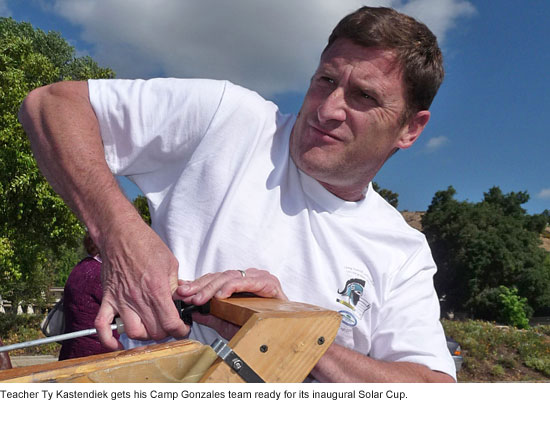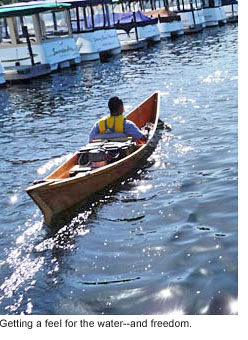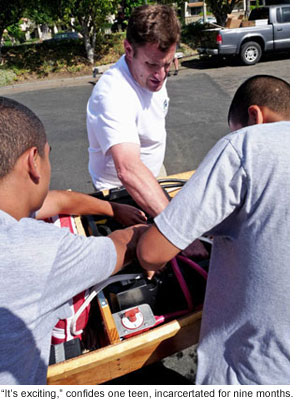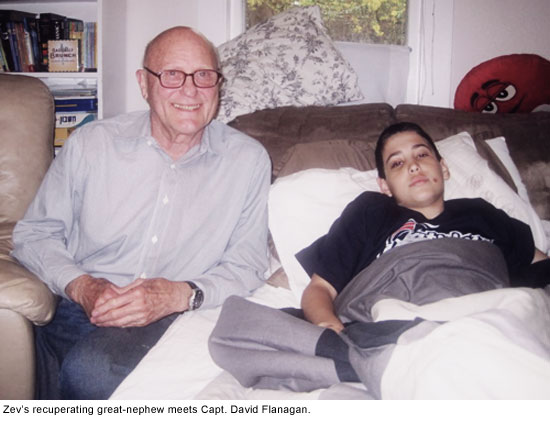Cruising the web for two-wheel news
May 17, 2011
Just in time for Bike Week L.A./National Bike Month, the Los Angeles County Bicycle Coalition has unveiled a new look for its website.
The site’s packed with news and tips, including a rundown on how to safely commute to work by bike and how to safely share the streets with motorists.
It also features downloadable bike maps, an overview of state bicycle laws and volunteer opportunities.
Even if you haven’t had a chance to take part in this year’s Bike Week L.A. festivities, another new website, Bike Beats Car, dedicated to the proposition that cycling beats driving for most urban commutes of 7 miles or less, is offering prizes to those who take part in its “bike to work challenge.”
Posted 5/15/11
Probation teens chart a fresh start
May 13, 2011
 For seven months, Ty Kastendiek’s kids have been readying the Miss Ann for this weekend. Some 20 pairs of young hands have helped build her — hammering, sawing, sanding, varnishing.
For seven months, Ty Kastendiek’s kids have been readying the Miss Ann for this weekend. Some 20 pairs of young hands have helped build her — hammering, sawing, sanding, varnishing.
Fifteen-feet-long, made of wood, she gleams in the sun and all but flies through the water. And to take her out is to know something Kastendiek’s kids appreciate perhaps more than most Southern California boaters: the joy of being free.
Kastendiek—or “Mister Ty”, as his students call him—is a veteran teacher at Camp David Gonzales in the hills above Malibu. Although he has been many things in his life—a purchasing executive, a contractor, an NCAA volleyball player, a Malibu surfer—he has spent the last 18 years teaching history, math and science to incarcerated teens for the Los Angeles County Office of Education. Last summer, he says, he was clicking around on the web when he came across an item about a boat race for high school science students.
“I thought, ‘I like boats’,” he laughed. “I also thought, ‘Yeah, and this would be a long shot.’”
Still, he couldn’t resist taking a closer look at the contest. Sponsored by the Metropolitan Water District, it required participants to build a solar-powered boat, write papers on the science behind it, pull together an environmentally-oriented public service ad and finally race the boat at a grand finale.
It would be tough, Kastendiek realized. Past winners tended to come from affluent suburban school districts, not juvenile lockup. But now, against all odds, he and a team of Gonzales students have cleared every hurdle and then some.
On Saturday and Sunday, they will compete against some 800 students from 40 Southern California high schools in the 9th annual Solar Cup at Lake Skinner in Temecula Valley.
“We’re rookies,” Kastendiek admits, “but I think we’ll make a respectable showing.”
“It’s exciting,” confides one of the teenagers on the team, a soft-spoken 18-year-old from Newhall named Richard who joined the project two months ago, toward the end of a 9-month stint at Gonzales.
 “I’ve never been on a boat like this before,” he said, smiling broadly during a test run this week in Westlake. “I thought I was just going to do my time and go home.”
“I’ve never been on a boat like this before,” he said, smiling broadly during a test run this week in Westlake. “I thought I was just going to do my time and go home.”
Solar Cup coordinator Julie Miller says the contest started as part of the outreach when the MWD was opening the Diamond Valley Lake reservoir in Hemet for recreation. The contest—part regatta, part science project—permits rookie teams to spend up to $4000 on their boats; more veteran teams are limited to $2,500 since, after the first year, they have most of the required parts.
Though only eight boats entered that first year, the Solar Cup is now the largest race of its kind in the nation. Miller says she frequently hears from former contestants. A member of one of the 2007 teams recently wrote to credit the Solar Cup with her decision to become an engineer, says Miller. Two more students who entered as part of a 2008 continuation school team e-mailed to say that the project had inspired them to go on, respectively, to the military and community college.
But this year’s race is the first to feature a team of incarcerated students, and there were some initial hurdles. For one thing, Kastendiek needed a water agency to sponsor the cost of boat building. At the MWD’s suggestion, he called the Las Virgenes Municipal Water District, which stretches from Woodland Hills to Westlake Village.
He wasn’t optimistic. Rules for rookie teams included attendance at two mandatory boat-building workshops; his team couldn’t travel without at least two sworn probation officers to oversee them. Most teams videotaped their public service announcements; his kids’ faces couldn’t appear on film due to court-ordered confidentiality restrictions.
Other teams could make their boats a yearlong class project, but the kids on his team came and went from Gonzales throughout the school year. The teenagers who built and designed the boat in November would not be the same teenagers racing it in May.
But Kastendiek’s call was music to the ears of the Las Virgenes district board members, says public affairs associate Deborah Low.
“We had tried in the past to engage the other high schools in our service area, both public and private, and had never found anyone who wanted to do it,” Low says.
The district’s one request was that the boat be named for the late Ann Dorgelo, a longtime board member from Agoura Hills who had advocated teaching local school children about water conservation.
The boat building began at the start of the school year, with seven or eight students chosen for their interest, their attitude and for their ability to maintain focus and calm, Kastendiek says.
MWD gives each team a basic kit, but the boats vary widely in their look and engineering. The Gonzales boat had to be almost entirely made of wood because the camp doesn’t have a machine shop or welding equipment. Also the design had to be simple—few of the Gonzales kids had ever even been in a boat, let alone built one.
Blueprints were drawn; calculations made. Kastendiek then won permission to take seven or eight kids (with the appropriate supervision) to the official boat-building workshop in early November.
“We built it in about five and a half hours,” he recalls proudly. “Some of those kids had never sawed wood before.”
The team, however, was every bit the revolving door that Kastendiek had feared.
A couple of the boat-builders got into trouble for fighting or defying other teachers and lost their spots. Others were so calmed by the project that they were sent home early for good behavior.
 Kastendiek says he tries not to know too much about his students’ back-stories, the better to give them a fresh start. But working with them day in and day out, it was hard to stay at arm’s length from their struggles. One kid who had thrown his heart and soul into the boat lifted his shirt one day to show Kastendiek the scars from five bullet wounds on his torso. “He told me he was glad he’d been locked up,” the teacher remembers, “because if he hadn’t he’d be dead by now.”
Kastendiek says he tries not to know too much about his students’ back-stories, the better to give them a fresh start. But working with them day in and day out, it was hard to stay at arm’s length from their struggles. One kid who had thrown his heart and soul into the boat lifted his shirt one day to show Kastendiek the scars from five bullet wounds on his torso. “He told me he was glad he’d been locked up,” the teacher remembers, “because if he hadn’t he’d be dead by now.”
By the New Year, the first crew of boat-builders was nearly gone from Camp Gonzales. Again, Kastendiek reached out. Several artistic kids came on to do an interactive print brochure that the group settled on as their public service announcement. (“I told them, “Let’s play to our strength—we have some of the best taggers in L.A. County’,” jokes the teacher.)
The laminated, flexagon-style brochure ended up winning a top prize in the rookie category of the public service part of the contest.
More fresh troops completed the boat’s construction. “Some of these kids were almost borderline hyperactive, and you’d put sandpaper in their hands and after a while, you could see their shoulders drop and all of a sudden, a joy there,” Kastendiek remembers. Still other students discovered a sudden affinity for math in the course of building the boat’s solar-powered engine.
Finally, this week, the boat was ready to hit the water.
“Take a deep breath. Take your time,” Kastendiek urged three team members this week at the Westlake Lake test run as reporters, water district board members, probation officers and assorted dignitaries bustled around them. Someone dropped a metal wrench on the battery. A spark flew. “Don’t worry,” Kastendiek repeated. “Try again.”
Down the shore, a competing team from nearby Oak Park High School unloaded their boat, painted a cheery yellow. Kastendiek’s kids watched from a distance in their orange camp-issued shorts and gray t-shirts as the suburban team confided that they were short-staffed because the AP Physics exams were being held that day.
But on the water, the Miss Ann seemed equal to almost any challenge. Christian, an 18-year-old from Long Beach, and Marco, a 16-year-old from Pomona, laughed out loud as she gathered speed.
“It was thrilling! It was so smooth, and the rudder was so simple,” their teammate Richard marveled as he finished his turn as skipper. None had ever steered a boat before that afternoon, said Kastendiek, who was smiling, too, as they loaded the Miss Ann back onto her small trailer.
“I hope we can make a loud statement that these kids have potential,” he says. “And I hope we can come back again next year.”
Posted 5/11/11
A music fest that won’t play second fiddle
May 12, 2011
If you’re having a hootenanny, you’ll be hard-pressed to find a better setting for it than the rustic western town of the Paramount Movie Ranch.
The Agoura Hills ranch, which has been the setting for numerous movies and TV shows – from Gun Smoke to Dr. Quinn, Medicine Woman – hosts the 51st Annual Topanga Banjo Fiddle Contest & Folk Festival this Sunday, May 15.
The festival began in Topanga Canyon with a few dozen fiddlers, banjo pickers, and about 500 fans. It was an instant hit, and moved to various locations around the area before settling at the Paramount Movie Ranch in 1990. This year over 160 contestants and between 4,000 to 5,000 visitors are expected.
The competition is open to beginners and professionals alike, who are judged alongside others of their skill level. Past contestants have ranged from age 4 to 98, and have hailed from towns and cities across the U.S. and world. Musicians compete for bragging rights and modest prizes, from $200 to a good meal at a local pub.
All attendees are invited to bring their own acoustic instruments and engage in impromptu jam sessions with the other musicians. Past contributors to the festival include singer Jackson Browne, Grammy-winning blues artist Taj Mahal, and blugrassin’ comedian Steve Martin.
Three stages of musicians will perform folk, blues, bluegrass, and more. Vendors will be on hand to sell food, or you can bring your own picnic. There will be arts and crafts for children, dancing, folk art and environmental booths.
The nonprofit contest and festival is co-sponsored by the Topanga Banjo Fiddle Contest & Folk Festival, Inc. and the Santa Monica Mountains National Recreation Area. Advance tickets can be purchased online and are $10 for adults, $8 for seniors and kids aged 10-17, and free for children under 10. Prices rise to $15 for adults, $10 for teens on the day of the festival. Parking is free, and directions to the ranch are available on the website.
Posted 5/12/11
Big giving on Big Sunday
May 12, 2011
 It started just over 10 years ago at a single local synagogue as a day of volunteerism for public-spirited congregants. Today, the effort has grown into Big Sunday weekend, an annual event that has become the largest regional community service event in America, engaging thousands of volunteers of all ages at hundreds of sites throughout the area.
It started just over 10 years ago at a single local synagogue as a day of volunteerism for public-spirited congregants. Today, the effort has grown into Big Sunday weekend, an annual event that has become the largest regional community service event in America, engaging thousands of volunteers of all ages at hundreds of sites throughout the area.
Sign up here to take part in some of the myriad activities in need of able-bodied volunteers this Sunday, May 15. In the Third District, University Synagogue, located at 11960 Sunset Boulevard, will serve as a Big Sunday hub location. There, between 9 a.m. and noon, join with family and friends in a variety of activities, ranging from sorting clothes to making and selling lemonade.
For full details, see the sign-up page, or call University Synagogue at (310) 472-1255.
Posted 5/12/11
Bugging out at Natural History Museum
May 12, 2011
 Bugs make up about 5/6th of all species on the planet, and not all of them want to invade your pantry. This weekend you can learn all about these magnificent creatures as L.A. County’s Natural History Museum holds its 25th annual Bug Fair.
Bugs make up about 5/6th of all species on the planet, and not all of them want to invade your pantry. This weekend you can learn all about these magnificent creatures as L.A. County’s Natural History Museum holds its 25th annual Bug Fair.
Brent Karner, entomologist and head organizer, says the event may be the museum’s best attended of the year, with an anticipated weekend turnout of more than 14,000 bug enthusiasts. It’s the largest bug event in North America, attracting scores of entomologists, educational groups, environmental groups, bug product purveyors and more—each with their own exhibition.
“The biggest draw of the event,” Karner says, “is the synergy between all those groups and what the museum itself has to offer.”
If you go to the Bug Fair, expect all sorts of bug-related madness. There will be a bug origami specialist, a cockroach race, tarantula feedings, bug performance art and live animal displays where you can hold the insects. Learn to pin bugs for your own collection and watch as bedbug-sniffing dogs show off their skills. The Natural History Museum is also home to an Insect Zoo and the popular Butterfly Pavilion.
New to the event this year is the Bug Chef “Cook-Off.” Four of the top insect chefs from across the country will take the stage to compete for culinary supremacy. Visitors will be chosen to judge the contest, and all are invited to sample the dishes (if you dare).
The Bug Fair is this Saturday and Sunday, May 14 and 15, during museum hours—9:30 a.m. to 5 p.m. The Fair is free with the price of admission, although there is a small additional cost of up to $3 for admission to the Butterfly Pavilion. Visit the website for directions, and avoid the $8 parking fee by planning your trip with Metro.
Posted 5/12/11
Artwalk the Miracle Mile with LACMA
May 12, 2011
Take your art “to go” with Los Angeles County Museum of Art’s Muse Artwalk 2011. The event partners museums, galleries, and independent artists to create an inspirational environment within the Miracle Mile community. It is organized by LACMA Muse, a group of art enthusiasts dedicated to promoting the arts and the community.
The following museums will open their doors for free this Saturday, May 11 for the Artwalk:
- LACMA, 11 a.m. to 8 p.m.
- Architecture + Design Museum, 12 to 6 p.m.
- Global Bazaar at Craft Folk and Art Museum, 10 a.m. to 6 p.m.
- Petersen Automotive Museum, 10 a.m. to 6 p.m.
LACMA will also host a variety of artist projects for the happening, including dance performances, jazz, installation art, readings from Amor Fati LA (an art and literature publication), free snacks and drinks, and a live mural painting.
 San Francisco video artist Stanya Kahn will be on hand at 1:30 p.m. to screen and speak about “It’s Cool, I’m Good,” an existentialist and humorous film she created.
San Francisco video artist Stanya Kahn will be on hand at 1:30 p.m. to screen and speak about “It’s Cool, I’m Good,” an existentialist and humorous film she created.
A Gallerina’s Guide, an award-winning multimedia dance and installation art show, will be presented at 4, 6, and 8:30 p.m. Check out a preview of the show on YouTube. RSVP is required, email [email protected] with “A Gallerina’s Guide” in the subject line and the preferred show time and number of guests in the body of the email.
More than 15 art galleries in the neighborhood of LACMA will also be participating in Artwalk 2011, which begins when the museums open and ends when all the galleries close. Do the environment a favor and plan your trip with Metro.
Posted 5/12/11
Side order of better service, please
May 12, 2011
George Abou-Daoud knows a thing or two about opening and operating a restaurant in this town—from a buzzed-about oyster bar/bistro to an old school Mexican-style cantina.
But with eight restaurants and six years in the business here, he’s mystified about one thing:
The county’s restaurant inspection process—especially when it comes to getting a new place off the ground.
“There is an unbelievable inconsistency in terms of what the different inspectors want you to do,” said Abou-Daoud, who’s preparing to launch the new Rosewood Tavern, which will join his other Hollywood restaurants including District, the Mercantile Wine Bar and Delancey Pizzeria & Bar. “Every possible way you can go about it, somebody’s got a different opinion.”
Then there are delays in plan approvals that can run well over the standard processing time of 20 days—and cost the restaurateur plenty as he pays rent on an unopened eatery. “When you buy a restaurant or lease a place, the clock is running,” Abou-Daoud said.
He’s not alone in his concerns. In response to such complaints, Los Angeles County Supervisors on Tuesday postponed until July 12 a vote on a Department of Public Health proposal to hike inspection fees for most restaurants—adjustments that the department says are necessary to cover its costs. (The department estimates that 72% of restaurants would pay more under the proposal, while the rest would pay less. In addition, in some cases fees would be assessed for services that are now free.) Before they approve any fee changes, the supervisors said, they want the department to come up with a plan for improving service, to get more input from the restaurant industry and to make the rationale for the proposed increases more transparent.
The board action came on a motion by Supervisor Don Knabe, who said that the fee hikes hadn’t been adequately communicated with “rate payers” in the industry who would be most affected. Amendments to the motion came from Supervisors Michael D. Antonovich and Zev Yaroslavsky.
Yaroslavsky said the department needed to speed up its plan check reviews, to offer “clear and consistent” interpretations of the food code and to rein in unprofessional behavior by some front-line inspectors. And it needs to do so without asking for additional resources.
“The problem with people at the lower end of the food chain is that some of them get a little carried away,” Yaroslavsky said, launching into a joke that Al Gore used to tell about crisscrossing the country during his presidential run and trying in vain to get a little extra chicken on his lunch plate during a picnic stop in South Carolina.
Gore asks for two pieces and is told that one is the limit. “And Gore said, ‘Do you know who I am? I’m Al Gore, and I’m running for President of the United States.’ The server said, ‘Do you know who I am? I’m the guy who serves the chicken.’”
Yaroslavsky said the Department of Public Health, along with other permit-issuing agencies, have some “little Napoleons running around who have a little bit of power, and they’re the people who serve the chicken.”
Dr. Jonathan E. Fielding, the county’s director of public health, agreed that the department could stand some improvements in the customer service department and could do more to integrate restaurant owners into the rate-setting process. He also said the department would post on its website a survey by an independent consultant that was used to establish the proposed increases, which would be the first since 2007. That survey measured the actual time it takes the department to perform each kind of inspection, and set the proposed fees accordingly—a more precise method than what was in place previously.
“We have to be very customer-sensitive and friendly while at the same time making sure that we enforce the state and local codes to protect the public health,” Fielding said.
Some restaurateurs say they’re afraid to complain about the process or about individual inspectors for fear of retaliation. But Fielding said they had nothing to fear, and should speak up about any problems. “If we don’t know about them, we can’t solve them,” he said.
As for Abou-Daoud—once described as a “mogul whose lounges are docked along Sunset Boulevard like ocean liners” by L.A. Weekly restaurant critic Jonathan Gold—he’s not griping about higher fees, as long they’re accompanied by improvements.
“Raise them—but offer something in return that saves us money on the back end,” he said.
Posted 5/12/11
Protect yourself from debt protection
May 11, 2011
 Life is unpredictable, the ads remind you. Don’t let your family suffer if you can’t pay your credit cards on time. Pay this “small” monthly fee and we’ll make, or even suspend, your payments if you experience a crisis.
Life is unpredictable, the ads remind you. Don’t let your family suffer if you can’t pay your credit cards on time. Pay this “small” monthly fee and we’ll make, or even suspend, your payments if you experience a crisis.
So-called “credit protection” plans are pushed relentlessly by banks, credit unions and other credit card issuers. But the Los Angeles Department of Consumer Affairs has some advice: Don’t buy.
“People think it’s really good, but they’re spending their money for, really, nothing,” says Rigo Reyes, the department’s acting director.” A recent report from the U.S. Government Accountability Office bears him out.
“Fees for these products can be substantial, with the annual cost often exceeding 10 percent of the cardholder’s average monthly balance,” according to the GAO, which is Congress’ audit and investigative arm. The credit card issuers, the report said, raked in $2.4 billion in fees for debt protection in 2009, more than half of it pure profit.
The plans are so full of exclusions and loopholes that card holders only received about 21 cents worth of actual benefits for every dollar they spent on “protection,” the GAO found. This 21% payout ratio is far lower than other types of insurance. The new health reform law, for example, mandates that payout rates for health insurance be at least 80%.
Once colloquially known as “credit insurance”, the plans are supposed to prevent penalties, fees and negative credit reports by keeping cardholders’ bills up to date should death, disability, divorce, job loss or some other emergency keeps them from paying on time.
But as state laws regarding insurance have been tightened, Reyes says, credit card issuers have changed the name to eliminate the word “insurance” and tweaked the product—now known as “debt protection”—so that it could be regulated under less stringent federal oversight.
Those federal rules are likely to tighten if and when the new federal Consumer Financial Protection Bureau comes online this summer as part of the financial reform act recently passed in Congress. But reform opponents hope to weaken the newly formed bureau and maintain the high profit margins debt protection offers to credit card issuers, at the expense of cardholders.
In the meantime, Reyes says, paying a dollar for 21 cents’ worth of coverage “isn’t a wise investment.”
“Save the money,” he suggests, “and use it to pay down the balance on your credit card.”
Posted 5/11/2011
When every second counts
May 11, 2011
The email from my sister started with the words: “He’s going to be OK.”
If she hadn’t opened that way, I’m not sure I could have kept my composure as I read what followed:
My 12-year-old great-nephew had been hit by a car as he walked home from school with friends in Brookline, Mass. The driver stopped and was screaming desperately for help when a retired 79-year-old U.S. Coast Guard captain named David Flanagan came on the scene, driving home after a gym workout with his wife.
When Capt. Flanagan saw that my great-nephew wasn’t breathing and had no pulse, he methodically started performing CPR. Happening upon the accident scene within minutes, perhaps even seconds, of the accident may have saved my great-nephew’s life. At the very least, it helped spare him more serious complications from a crash that, as it is, left him with a broken femur, a cracked skull and a major concussion.
Paramedics showed up shortly after, and our “first responder” didn’t hang around for thanks or acknowledgement as my great-nephew was rushed to the renowned pediatric trauma center at Children’s Hospital Boston.
I’m telling this story not just to publicly thank Capt. Flanagan—who despite his modesty represents remarkable courage, decency and skill—but also to marvel at what a difference having rapid access to skilled trauma care can mean, especially for children.
As we voted this week to distribute funds to our county’s trauma and emergency care network, including $1.6 million in startup operating funds for Northridge Hospital’s new Richie Pediatric Trauma Center, my great-nephew’s brush with disaster reminded me of what an important investment that is. The Richie center is the only facility of its kind serving the vast San Fernando Valley, and one of just seven offering this specialized, vitally important care in the entire county. Before the Richie center opened last year, some 300 kids annually had to be transported from the Valley to Children’s Hospital in Hollywood or UCLA’s pediatric trauma center for care. Sacramento has contemplated shifting funds from such trauma centers to help bridge its severe budget gap, but clearly we cannot afford to erode our emergency and trauma network any further.
The “golden hour” in medicine refers to that brief window of time when medical attention can mean the difference between a good outcome and a tragedy. For kids, that window is even smaller because they’re generally less able to compensate for injury and blood loss as effectively as adults. For them, the most good can be done during the “platinum half hour”—and in an area as spread out as the San Fernando Valley, this life-saving resource is long overdue.
My great-nephew spent five days in the hospital and now is back home and on his way to a full recovery. He’ll miss school for several weeks and will be in a wheelchair for a couple of months. Over the phone, I joked with him that the accident had given him good material for his college application essay. He joked back about the Lakers’ playoff humiliation.
I can’t say enough about how much it meant to be able to kid around with him, and how grateful I am to Capt. Flanagan and the professionals who made it possible. (It made all the difference that the captain knew CPR—a reminder to all of us that this is a skill worth learning, and refreshing, at classes offered regularly by the American Red Cross throughout Los Angeles County.)
Of course, we can’t guarantee there’ll be a CPR-trained Good Samaritan passing by every time a kid gets hurt. But by providing funding to the newest member of our county’s pediatric trauma care network at Northridge Hospital, we can greatly improve the odds of injured children getting the help they need—when they need it the most.
Posted 5/11/11















 Check for the latest closure information
Check for the latest closure information








